Table of Contents: Intro & 1920; 1921-1923; 1924-1927; 1928-1932; 1933-1935; 1936-1939; 1940-1945; 1946-1949; 1950-1953; 1954-1956; 1957-1959; 1960-1963; 1964-1966; 1967-1969; 1970-1973; 1974-1976; 1977-1979; 1980-1983; 1984-1986; 1987-1989; 1990-1993; 1994-1996; 1997-1999; 2000-2003; 2004-2006; 2007-2009; 2010; 2011; 2012; 2013; 2014; 2015; 2016; 2017; 2018; 2019; Recap & 2020; 2021; 2022
Just a reminder that we’re still running our Crowdfunding campaign to support Buggy100 on April 16-18, 2020. If you haven’t donated already (or even if you have), please consider giving to the Crowdfunding so that we can make Buggy100 the event that it deserves to be. Click here to view the Buggy100 Crowdfunding page.
This week, the 100 Years of Buggy History series focuses on the late 1980s. This three year period brought the largest increase in the number of organizations participating in Buggy since the early years of racing, with 1987 alone introducing 3 new buggy organizations. But with more teams came more consternation from the Student Senate. The addition of teams happened to coincide with a complete rewrite of the Buggy rulebook. The period also brought the first (and so far only) Spring Carnival snowstorm, while one team took a Quantum Leap towards all-time greatness. And the period also taught us that sometimes it’s good to be the King…and sometimes it isn’t.
1987
Raceday: Prelims on Friday, April 10 at 7:00am; Finals on Saturday, April 11 at 8:00am
Sweepstakes Committee: Shawn Stufft (Chair); Tricia DiMarco (Ass. Chair); Steve Ng (Safety); Kathy Flannery (Design); Olve Peersen (Buggy Book)
Men’s Results: (1) Spirit A – Sting (2:11.35); (2) Beta A – Nike (2:12.27); (3) PiKA A – King Solomon (2:13.22); (4) PiKA B – Breathless (2:15.54); (5) CIA A – Stealth (2:15.62); (6) KDR A – Phoenix (2:17.01)
Women’s Results: (1) Spirit A – Sting (2:37.34 – COURSE RECORD); (2) CIA A – Stealth (2:40.18); (3) PiKA A (2:52.23)
Design Comp: (1) SigNu; (2) Fringe; (3) CIA
Weather: Sunny, 36-62 Degrees on Friday; Cloudy with Late Rain, 49-60 Degrees on Saturday
Buggy Book: 1987 Buggy Book Link
Prediction Score: 16/45 Men’s, 10/10 Women’s (Compubookie)
The big news from 1987 was a new Buggy rulebook, totaling 83 pages, that came out of the committee assembled after the ATO fire of 1986. But that wasn’t all; a bunch of new teams and a very controversial Finals made for an interesting year in the world of Buggy.
- Sweepstakes Budget. The November 11, 1986 Tartan gives us a little insight as to where the Sweepstakes budget stood for the 1986-87 school year. For the year, Student Senate had allocated $6,810 for Sweepstakes. We also have a note from April 14, 1987, that Spirit added $300 to their buggy budget for 1988 so that they could rent a truck for Raceday. Spirit also sought a vote to increase their buggy dues to match CIA’s, but the vote failed.
- Pioneering A New Era. In 1987, a group of students decided that they wanted to participate in various on-campus events, but didn’t want to join one of the existing organizations (or fraternities). So they banded together to create a new independent organization, Pioneers. The organization was formed to do more than just Buggy – they also built a booth and fielded IM sports teams – but Buggy seems to have been one of the main purposes. Unfortunately, they got started a little late and wouldn’t be able to compete until 1988.
- New Greek Organization. Pioneers wasn’t the only new organization to participate in 1987. Our last record of Kappa Delta Rho (KDR) participating in Buggy was from 1928, when they were still the local fraternity Delta Mu. They had stopped participating by the time the fraternity became KDR, and the fraternity did not make it through World War II, as it was one of several that appears to have failed to restart after the veterans got back from the war. But the fraternity started back up again in 1986, and officially received IFC recognition on January 21, 1987. So with their new status, the decided to get involved in Buggy, and according to Shafeeq (see the comments), they began by purchasing CIA’s Darkstar, repainting it and renaming it Renaissance, while also building a buggy of their own, Phoenix, to race on Raceday.
- AFROTC Flies Into the Field. And a 3rd organization joined the fray as well. The Air Force ROTC decided that they wanted to give Buggy a shot as well. So they built their own new buggy, Eagle, to take flight for the first time.
- New Safety Rules. As noted last week, following the numerous incidents during practice rolls and the ATO fire in 1986, Anne Witchner put together a panel, consisting of the current Sweepstakes committee and alumni Tom Wood (PiKA), Lou Conley (CIA), H. Sanford River, Dave Lamont (SigNu), and Bill Grathwohl (Theta Xi), to rewrite the rules. The result was an 83 page-long rulebook, much of which is still in place today. The revision process began in September 1986, and the new rules were announced on January 5, 1987. We won’t list everything out here (these articles are already long enough), but below are some of the more significant new additions for safety:
- Additional Brake Tests – In addition to the standard capes/drops test with buggies braking within a certain distance, an additional test was added for the buggy to be pulled backwards while the driver brakes, to prove that the brakes worked in both directions. The purpose was to avoid issues during tailspins or if an unattended buggy began rolling downhill.
- Gloves – Drivers were required to wear leather gloves if their buggies had internal moving parts or a removable shell between the driver’s hands and the road.
- Helmets – All drivers were required to wear hockey-style helmets; provided that this rule was delayed until January 1, 1988, if the helmet-wearing driver could not fit in a buggy that otherwise satisfied all of the safety requirements (thus allowing buggies that had already been preparing for Raceday 1987 to race one final time)
- Safety Harnesses – All drivers were required to wear a safety harness based on a prototype designed by Sweepstakes (rather than harnesses determined by each org separately). Due to the initial high cost of the harness ($200), organizations were only required to buy 1 harness per year, until they had enough for all of their buggies, though Sweepstakes expected the harness price to go down over time.
- Roll Cage – Each buggy was required to contain an additional structure, braced every foot, that encloses the driver and can withstand at least 500 pounds of pressure on the top and sides.
- Dropping Pushbar Restrictions – Pushbars were no longer allowed to drop backwards (or sideways), as they could no longer rest beyond the perimeter of the buggy.
- Windshield Construction – Beginning on January 1, 1988, all windshields must be constructed with LEXAN and bolted to the protective cage. In addition, all windshields used during push practice must be clear (for practice rolls and Raceday, the LEXAN may be tinted).
- Interior Windshields – For buggies with an interior front wheel (standard trike), the buggy must contain an interior windshield that is constructed and fastened like the exterior windshield.
- Goggles – For buggies with an interior front wheel (standard trike), all drivers must wear goggles.
- Driver’s Education – All drivers must attend education sessions that review race and practice procedures, course terrain and strategies for normal and emergency situations.
- Trucks – Trucks may only be enclosed by curtains, not doors. In addition, no flammable chemicals or open flames are permitted inside the truck.
- Reaction to the New Rules. The response from current students was decidedly mixed, and the January 27, 1987 Tartan got some reactions from the teams. One of Beta’s Co-Chairs didn’t think the new rules were necessary, stating that “we would never race a buggy that wasn’t safe”, while CIA Chair Michael Swamp took the opposite view, noting that “the competition will definitely be safer. Some people were rolling garbage.” Some also pointed out that the introduction of these new rules could have negative impacts. Both Beta and CIA pointed out that the rules about windshields could actually make the buggy less safe, as windshields have a tendency to get dirty and fog up, so more windshields increases the likelihood that vision will be obscured for some reason. Another issue came from the roll cage rules, as some chairmen questioned whether 500 pounds was an accurate assessment of how much impact a buggy could be subject to in the event of a crash, and how to properly test the load capacity. And the biggest complaint seemed to be voiced by Matt Wagner, Spirit’s Co-Chair, who objected not to the rules themselves, but with announcing new rules just 8 weeks before Spring rolls begin. Teams who were building new buggies had to wait until the new rules were announced, and most teams would then need to spend the time conforming all of their old buggies to the new rules. This can be both time consuming and expensive, which limited what steps the teams could take, and without a phase-in period, many teams were at a disadvantage for the 1987 year. But Sweepstakes Chair Shawn Stufft made the point that the high tech buggies were not the issue and may have needed fewer, if any, changes. Instead, the problem was the lower-end buggies, which were very marginal and had far greater safety flaws.
- Design Comp Changes. The new rules didn’t just affect the safety rules; they overhauled the entire rulebook. One impact was to make the Design Competition more enjoyable for spectators. Prior to 1987, only the buggies entered into the actual Design Competition were put on display. The new rules now required that all buggies entered to race on Raceday were required to be on display (rather than just those entered in the Design Competition). This allowed spectators to see all of the racing buggies in a single place, which would hopefully make Design Competition more popular. But current students weren’t all a fan of this rule either, as a Beta Co-Chair pointed out to the Tartan that by being required to display all of their buggies at Design Competition, it would give the organization less time to prepare for the races.
- Future Year Implications. Another new rule that was passed was an attempt to prevent gamesmanship of entries. If a team reserves a lane for Raceday but didn’t enter a buggy in that lane, the team is prohibited from rolling all of its buggies the following year. The rule was added by the alumni to prevent orgs from scheduling heats without having enough buggies to fill them. However, this rule was temporarily waived as a result of a number of buggies failing to qualify for Raceday after the new safety rules were passed, and it’s unclear if this rule ever actually came into effect. In fact, had this rule been in place, 9 different organizations would have been affected for Raceday 1988.
- Who’s Your Nemesis? An interesting duel took place in 1987 between Theta Xi and SigNu, but it happened well before they reach the course. Both organizations built new buggies, and both named those buggies Nemesis. Both teams even went so far as to design buggy t-shirts based around their new buggies’ name. But in the unwritten rules of competition, you can’t have two buggies with the same name for different organizations. There was some disagreement between the two fraternities over who should get to use the name, but ultimately Theta Xi won the battle when SigNu alumni arrived for Carnival and renamed their buggy Pope Jackson. Pope Jackson was SigNu’s 3rd consecutive attempt at a carbon sandwich based buggy, making the buggy one of the lighter ones on the course. But while the experience building this type of buggy allowed SigNu to make a body with a low mass/high stiffness body, they hadn’t quite cracked the right way to mount the 3 wheels to the buggy in a way that worked as well as the older, truss-based designs.
- New Buggies of 1987. A number of new buggies were built in 1987. In addition to the two Nemeses, Theta Xi also built a second new buggy, Valkure. The new organizations AFROTC and KDR built their new buggies (Eagle for AFROTC, Phoenix for KDR), while Pioneers started but didn’t finish their new buggy, Pinnacle. DU attempted to debut their new two-wheeler from 1986, Biakar. ATO, DTD, and PhiKap produced Rebel Yell, Suspicion, and Duke, respectively. Beta built a new buggy named Xavier’s Revenge, and KapSig rolled out a buggy named Electric Banana (though we don’t know if this was a new build or a renaming of an older buggy). And last, but certainly not least, Spirit produced a buggy that would go on to change the world – Quantum Leap.
- Buggies Have Trouble Qualifying. Due to a freak snowstorm that rolled into Pittsburgh during truck weekend, several teams had trouble getting their buggies qualified for Raceday. Of the 11 rolls scheduled, only 7 actually occurred. Pioneers was excited about participating, but it turns out they couldn’t get their buggy built in time, and therefore they had to scratch from Raceday 1987. PiLam was unable to successfully complete their pass test. Meanwhile, KapSig, ATO, and DU all failed to meet the minimum number of rolls required to qualify (which, at the time, required 5 rolls for the buggy and 3 for the buggy/driver combo, plus a pass test), so none of those 3 teams were able to compete on Raceday. Furthermore, SAE, SDC, PhiKap, and DTD could not get all of their buggies qualified, and therefore they were going into Raceday with fewer teams than they had initially planned. Not everyone had trouble however; AFROTC was one example, as they got their buggy qualified in just 1 day. Sweepstakes did make one general exception to the qualification rule – For teams that had gotten at least 1 roll in with their buggy (which was every team other than Pioneers), they would be allowed to participate in an Exhibition race. But unsurprisingly, not everyone was happy about this decision. An editorial in the April 14, 1987 Tartan argued that people take Carnival (including Buggy) too seriously, as exemplified by the fact that the 5 organizations listed above were DQ’d for “procrastinating”. The article argues that President Cyert could have gotten permits to close the roads in order to get those teams that still needed rolls and pass test qualified prior to Raceday, but the Buggy Chairs decided that these orgs didn’t deserve the privilege of racing because they waited until the last minute. We think that the situation was probably more complicated than that though.
- Predictions. For the first, but certainly not the last time, Compubookie was criticized for its predictions. Compubookie took some shots at Lou Conley in the predictions, but other than that only included his 1-sentence org summaries and his Top 6 Men’s/Top Women’s/Best and Worst Heat. A Letter to the Editor in the April 21, 1987 Tartan signed by 7 members of KDR called Compubookie a “useless service”, stating that the article was a “poorly researched, inaccurate, and sarcastic document.” The Letter to the Editor prompted the Tartan’s editorial staff to respond, clarifying that Compubookie is not a Tartan writer but an anonymous member of the campus community, and that “this year’s column was heavily edited prior to publication. Because of the unprintable quality of parts of the column, the tradition may be discontinued.” But for the record, Compubookie’s predictions were: Men’s – (1) Beta A, (2) PiKA A, (3) CIA A, (4) SigNu A, (5) Spirit A, (6) PiKA B; Women’s – (1) Spirit; Best Race – Men’s Heat 7; Worst Race – Men’s Heat 10a (see below). The PiKA A 2nd place prediction was based on the fact that PiKA lost 4 of their 5 A team pushers from 1986.
- Special Prelims Heat. 2-wheeled buggies have long posed a dilemma for Sweepstakes; they are arguable the fastest type of buggy to race, but they are so inherently unstable, particularly when being pushed, that they pose a significant safety risk, not just to the drivers but also to the other teams in their heats. The new safety rules did not outright ban 2-wheeled buggies from competing. But Sweepstakes did make another decision to minimize the impact of DU’s 2-wheelers. They created a special Prelims Heat, designated as Heat 10A, for both of DU’s 2-wheelers, Horned Screamer and Biakar, to compete (they were scheduled to go up against PiLam B). However, as noted above, neither DU nor PiLam were able to qualify for Raceday, and so this special 2-wheeler heat was taken out of the Prelims and moved to an Exhibition. Only 2 of the three buggies ended up competing – DU A’s Biakar and PiLam B’s Miss Budweiser. And the race proved why the 2-wheelers were moved to their own heat, as Biakar did not finish the race, spinning out in the chute and falling over.
- Women’s Races. The Women’s races were a 1-day affair, taking place on Saturday. We don’t have any interesting stories from the day, so we suspect that the rolls were relatively uneventful from an incident standpoint (and the Tartan did what it often did, which was largely ignore Women’s racing, which Spirit complained about in a Letter to the Editor on April 21). Spirit A, with their new buggy Sting, won by 6 seconds, defeating CIA A and setting a new course record, but it was really a 2-team race, as it was another 13 seconds back to PiKA in 3rd.
- Alumni Heats. There were 6 Exhibition/Alumni Heats planned for Saturday morning, but only 2 ended up competing. The fastest time went to SigNu, who, according to Mark Estes in the comments below, rolled their Men’s D team buggy, Colugo with fully prepped wheels and their 1985 push team. We don’t have the time. The other races were delayed until after the Women’s and Men’s races, due to the threat of rain on Saturday (which, as you’ll see below, meant that they never happened).
- Major Finals Controversy. The Tartan’s coverage of Raceday was lackluster, with no photos of the top buggies or description of the races. According to the comments section of the BAA website, there were plenty of spins in 1987, but the only 2 incidents that we know of on Friday were spinouts of Spirit C and SigNu A. But the same can’t be said for Saturday. The Men’s heats began normally. And with Spirit A, the Friday leader, still to race, Beta A’s Nike put up the time to beat with a 2:11.73. Beta A had the 2nd fastest time on Friday, so we think that this time was set in Finals Heat 4 (the Tartan implies that this was in Finals Heat 1, but based on the Tartan’s poor coverage of Raceday itself, we suspect that this implication is wrong). Per Tom Wood, for some reason (which we don’t know), Beta’s heat was followed by an Exhibition Heat, before Spirit A made their way to the Starting Line. Once the exhibition ended, Spirit A’s Sting (the fastest Friday time) lined up in what we believe was the final regular heat (though rerolls were still to come) against Beta B (the 7th fastest Friday time; the buggy was identified in the Tartan as “DLB”, but we’re not sure if this was Challenger or the new buggy, Xavier’s Revenge), and both buggies were at the starting line ready to go. Suddenly, water started to fall from the sky, and Spirit’s chair voiced his concern about the safety implications of the rain. The countdown got down to 15 seconds when Sweepstakes Chair Shawn Stufft made the decision to hold the race. He called for a 5 minute delay in hopes that the rain would stop. When it didn’t stop after 5 minutes, he pushed the delay to 30 minutes. But it wasn’t enough, as there was water on the roads. Furthermore, once it started raining, the Pittsburgh Police and EMS left the course. The roads had opened and cars were driving through, so at that point there was nothing Sweepstakes could do. They were forced to cancel the rest of the heats. And since not all of the teams had put up a Finals time, the Finals were wiped out of the record books and the Day 1 times were declared final. This made Spirit the winner, in just their 3rd year of racing (successfully completing their 3 year plan to glory).
- Awards Drama. Given how the Finals went down, it’s not surprising that Beta was not thrilled about the result. According to the Tartan, when Beta was announced as the 2nd place winner at Awards Ceremony, many in the crowd booed and Beta refused to accept their trophy. When Spirit was announced as the winner, Spirit’s chair took the microphone and stated “we didn’t want to win the back way. Beta, we’ll be here next year.” Beta didn’t love that remark, and one of their brothers reportedly tipped over the first place trophy. Beta’s chairman took the microphone from the Closing Ceremonies Chairman and stated “what counts is the times on Saturday rolls. You guys don’t deserve it. We’ll trade our trophy for yours anytime, anywhere, the rest of the year – we’ll be here.” Beta then left the stage. Beta’s chair apologized for their reactions in a phone call to Spirit’s chair the following day, explaining that his issues were not with Spirit, but rather with the individuals making the decision to cancel rolls on the last heat. As a note though, the Tartan’s reporting here is a little questionable. In addition to claiming that there were 3 heats to go when the rain started to fall (when it seems pretty clear that there was only 1 heat remaining), it also accused Spirit of setting off smoke bombs after being announced as the winner, though a Letter to the Editor in the April 21 edition corrected the record, clarifying that it was not a smoke bomb, but rather AB Tech’s fog machine, that created the smoke.
- SigNu’s Finals Manipulation. It didn’t end up mattering because of the controversy discussed above, but in the comments below, Mark Estes gave us an interesting look into SigNu’s Raceday. Thanks to alternates, SigNu was able to put 4 of their 5 A team pushers on their B team buggy, Pope Jackson, for the Finals, after the A team spun out during Prelims. But Pope Jackson wasn’t a very fast buggy, and in the Finals, they ran into problems; namely, a curb. SigNu was neck-and-neck with the other buggy (which we believe was PiKA A’s King Solomon) as they went up the front hills, but since PiKA was coming from the inside lane, they had the better angle and the buggy squeezed SigNu’s Pope Jackson between the PiKA buggy and the curb at the start of the freeroll. Unfortunately for SigNu, there wasn’t enough room to get through, and they hit the curb, damaging the front left wheel. The resulting time was slow, so SigNu requested a re-roll, and argued that the buggy was unable to be repaired in such a short period of time. The rules were unclear about what to do in this situation, but since the B team driver was qualified in 2 different buggies, Pope Jackson and the Men’s D team buggy, Colugo, Sweepstakes was willing to grant the reroll request as long as PiKA also approved. A deal between the chairmen was struck, and SigNu was granted the reroll with Colugo. Unfortunately, due to the rain, SigNu never got a chance to see if they could have set a winning time.
- 1987 Photos. Below are some photos that we have from 1987.
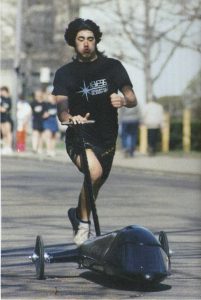
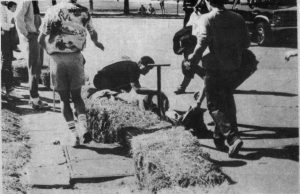
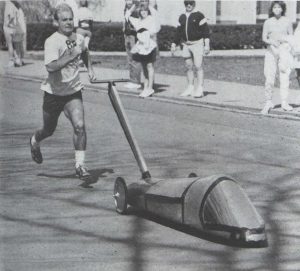
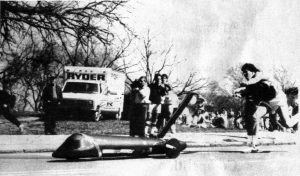

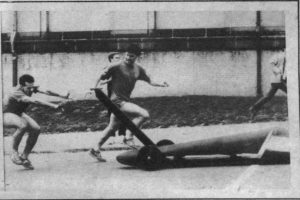




Left Buggy (from left to right): Men’s B with Renaissance: Ken Nash (Hill 5), Dan Galvin (4), Darin Mar (3), Brett Bosley (2), Doug Armstrong (1), Laura Lemay (driver)
Right Buggy (from left to right): Men’s A with Phoenix: John Frost (Hill 1), Stu Vernon (2), Marc Phillips (3), Dan Dunbrack (4), Anton Ogno (5), Brenda Raich (driver)


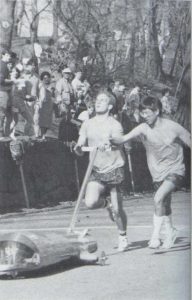


1988
Raceday: Prelims on Friday, April 15 at 7:00am; Finals on Saturday, April 16 at 12:00pm*
Sweepstakes Committee: Gino Cosentino (Chair); Chris Hansen (Ass. Chair); Phil Tubesing and Trish DiMarco (Safety); Maureen Yim, Lori Brassaw, and Kelly Krummert (Design)
Men’s Results: (1) Spirit A – Quantum Leap (2:06.2 – COURSE RECORD); (2) PiKA A – Predator (2:09.2); (3) SigNu A – Jerboa (2:11.4); (4) Spirit B (2:13.7); (5) PiKA B – Thunder (2:14.4); (6) Beta A (2:14.6)
Women’s Results: (1) PiKA A – King Solomon (2:37.6); (2) Spirit A – Quantum Leap (2:39.6); (3) Spirit B – Sting (2:50.3); (4) CIA A; (5) Beta A; (6) Fringe A (DNF)
Design Comp: (1) Pioneers – Pinnacle; (2) Spirit – Quantum Leap; (3) SigNu – Pope Jackson
Other Awards: DTD = T-Shirt; Fringe = Essence of Buggy
Weather: Cloudy, 38-46 Degrees on Friday; Snow Flurries, 35-40 Degrees on Saturday
Buggy Book: 1988 Buggy Book Link
Prediction Score: 19/55 Men’s, 10/27 Women’s (Compubookie)
1988 is one of the most famous years in Buggy, as we’ve got course records set by 2 famous buggies and 5 famous wheels, with a snowstorm to boot. But we’ve also got some more unknown stories from the year.
- Safety Chair(s). 53 buggies were on display during Design Competition in 1987. In preparation for another large crop of buggies in 1988, Sweepstakes elected not 1, but 2 Safety Chairs in order to help with the volume. They elected Tricia DiMarco, the Ass. Chair in 1987 and a Theta Xi pusher who was also one of CMU’s top cross-country runners, and Phil Tubesing, who had spent the previous 2 years as SDC’s Head Mechanic.
- Buggy vs. Student Government, 1988 Edition. A couple of Buggy-related items were approved by Student Senate in 1988. One was the Sweepstakes budget, which rose from $6,810 to $8,735. The other was the official recognition of Pioneers as a Student Organization. As a result of that recognition, Pioneers was allocated $650 from Student Senate. But Pioneers’ addition to the fold now meant that 4 teams were receiving Activities Fee funds for Buggy, and this brought about some changes to Student Senate’s fiscal policy for funding Buggy organizations. The initial proposal, proposed by Sen. Charles Jainchill, called for a certain amount of money from the Activities Fee each Spring to be set aside for Buggy orgs, with the organizations receiving the money based on need. The money set aside could only be used to cover operational expenses, improvements, and repair and maintenance of buggies; the money could not be used to build a new buggy. This did not sit well with Buggy people, and “almost immediately” Sen. Glenn Kornbrek proposed an amendment to the initial proposal, allowing organizations to use the money to build new buggies, provided that the organization self-fund 10% of the cost of the new buggy build (this would even the playing field with fraternities, who can fund new buggies through dues and/or donations). A debate among the Student Senators erupted, but in the end, the Kornbrek amendment won out, and money allocated to organizations from the set-aside funds could be used to build new buggies.
- Buggy vs. Police, Part 1. At 12:43am on March 7, 1988, Buggy teams were out at Push Practice when a campus police vehicle came speeding down Schenley Drive with a right turn signal on, looking to turn onto Tech Street. Reportedly, the officer was responding to a medical emergency. Organizations were on Hill 1, and the standard procedure was to stop cars that want to drive through, ask them to turn off their headlights, and wait until the hill is clear before letting the cars proceed. Barricades were set up at the top of the hill, though there was room between the barricades for a car to get through. So the flagger positioned at the barricades started to flag down the vehicle. As the car got closer, the flagger realized that it was a police vehicle, and that the vehicle wasn’t slowing down. At that point and without slowing down, the officer turned on the flashing lights and proceeded to drive through the barricades. The flagger was forced to dive out of the way of the vehicle. Meanwhile, a buggy was currently on Hill 1. As the officer sped down Hill 1, several members of the organization yelled out for the officer to slow down. Near the bottom of Hill 1, the organization’s chair was upset that the car had driven down the road with a buggy on the course, which could have caused a serious accident. The Chair shouted at the officer, calling him a “dick.” This did get the officer to stop his car; he proceeded to confiscated the Chair’s ID and cited him for disorderly conduct (the officer claimed, per the March 15 Tartan, that the student had “acted disorderly and was uncooperative”).
- Buggy vs. Police, Part 2. It just wasn’t a good year with police and Push Practice. According to the April 12, 1988 Tartan, Sweepstakes Chair Gino Cosentino and Pittsburgh Police reportedly got into a disagreement over whether Sweepstakes had the proper permits to conduct Push Practice on April 6. We personally side with the Sweepstakes Chair, but the Pittsburgh Police ended up winning this battle and Push Practice was cancelled for the evening.
- AFROTC Reveals All. Some organizations employ extra security to protect their buggy secrets, but AFROTC decided to go the opposite route. As a newer organization, AFROTC decided that if anyone wanted to steal any of their buggy secrets, the theft would only be beneficial to AFROTC. So they took the buggy they built in 1987, Eagle, stripped it down and renamed it to Stratofortress. You may not recognize the name, but if you know about older buggies, you may know Stratofortress for its most unique feature – the buggy was completely transparent. Yes, anyone looking at the buggy would know exactly how its components work, because AFROTC removed most of the aluminum used in the body of the buggy and replaced it with material that was fully see-through. In 1989 they would go even further – since the buggy was already see-through, why waste the money on a truck?
- AEPi Enters The Fray. The late 1980s saw a huge expansion on the number of different organizations participating in Buggy. The final new team from the era made their debut in 1988. The brothers of Alpha Epsilon Pi (AEPi) originally joined the CMU campus in 1985, but after refounding in 1987, they decided to try their hands at Buggy. To start off, they acquired a 3-wheeled buggy from PhiKap (we’re unsure of which one), and according to Jay Kirschenbaum, then-AEPi Buggy Chair, one of the AEPi brother and his then-girlfriend (now wife) drove to Morristown, NJ during the summer of 1987 to pick it up. The brothers brought it back to Pittsburgh and constructed a new roll cage and shell to conform with the new safety rules, renaming the buggy Giant Eagle (after their first “buggy”, a Giant Eagle shopping cart, that was rolled down Forbes Avenue the night after the initial founding of the fraternity).
- The Sting and Racer-X Report. In the November 10, 1987 edition of The Tartan, a new column called “The Sting and Racer-X Report” made its debut. This column, co-written by 1987 Safety Chair Steve Ng and 1987 SigNu Chair Mark Estes, was meant to report on the on- and off-course happenings in buggy, to fill the hole that the Tartan has typically left in Buggy coverage throughout the year. The first article was essentially a Fall rolls report. The fall was “unusually rain free”, as only 1 weekend was cancelled, and rolls went relatively smoothly, with faster times being clocked than previous fall semesters. The fastest teams through the fall were (1) PiKA, (2) SigNu, (3) DU, (4) KDR, (5) CIA, and (6) Fringe. DU’s 2-wheeled buggies were showing more stability, though they weren’t flawless and had some Hill 1 issues. SigNu had 3 fast buggies working on a new Chute line to help avoid the spinouts that they had experienced in recent years. CIA switched Chute lines to something closer to what SigNu had previously used, and although Spectre was rolling well, Black Magic had not been seen on the course. PiKA was the fastest of the early teams, though they didn’t have the same urgency for getting rolls in that they had in previous years. AFROTC’s “rolling mailbox” got a new look and pneumatic tires on the back, and the team looked much improved. Both Pioneers and AEPi made their debuts, but neither went fast (though new wheels in the Spring allowed them to look a little better). Meanwhile, PiLam, KapSig, ATO, and SAE skipped fall rolls entirely. In the Spring, inclement weather hurt the number of rolls, and several teams, including KapSig, PiLam, Pioneers, AEPi, and ATO, came down to the wire with respect to qualification, needing Truck Weekend to get their buggies qualified.
- Sororities and Added Finals. A total of 21 Women’s teams from 11 different orgs lined up to battle for the trophy on Raceday. Sororities weren’t officially included in the 11 organizations, as none of the sororities on campus ran their own buggy teams. They did, however, bring their own push teams, aligning with different fraternities to push in the Women’s division. Kappa Alpha Theta once again continued their partnership with PiKA. Delta Delta Delta (TriDelt) paired up with SigNu. And Delta Gamma (DG) made a switch; previously, they had pushed for PhiKap, but in 1988 they switched to a team with better buggies, electing to push for Beta. This was the second year in a row with such a large number of Women’s teams, and Sweepstakes finally gave the Women’s heats a similar level of respect to the Men’s races. For the first time, Sweepstakes decided to hold 2 days of Women’s racing, with a Prelim/Finals setup similar to the Men’s races.
- Predictions. Compubookie’s predictions for 1988 were as follows: Men’s – (1) Beta A, (2) Spirit A, (3) PiKA A, (4) DU A, (5) SigNu A, (6) CIA A, (7) KDR A, (8) PiKA B, (9) Beta B, (10) Theta Xi; Women’s – (1) Spirit, (2) Beta/DG, (3) PiKA/Theta. But the April 12, 1988 Tartan didn’t just include Compubookie; it also included predictions from Head Judge (and former Safety Chair) Steve Ng. He didn’t make the brave attempt to name a top order, but rather predicted that on the Men’s side, the top teams would be Beta, PiKA, Spirit, CIA, and SigNu (but not in that order). He did, however, note that the most exciting battle would be for the 8-10 spots, which could come down to KDR, Theta Xi, and Fringe. He also told readers to watch out for DU, who had been putting up impressive times in practice but struggled with stability of their 2-wheelers. On the Women’s side, Steve listed 6 teams that he expected to do well: PiKA/Theta, Spirit, SigNu/TriDelt, Beta/DG, Fringe, and CIA.
- Winter Carnival. Technically, Spring Carnival takes place in the Spring, and most years no one would question that (even though it can feel a little chilly). But in 1988, people must have thought that they have gone through a wormhole and headed back to January. Friday’s Raceday was fine precipitation-wise (rain was forecast, but in ended on Thursday afternoon), but it was very cold, hovering in the upper 30s to low 40s throughout the Raceday. Saturday, however, was a whole different story. The temperature dropped to below 30 for the scheduled 8am start time, but even more importantly, snow began to fall. The flurries had Sweepstakes considering cancelling the Finals, but instead they merely postponed the races, pushing the start time back from 8:00am to 12:00pm. According to the April 19, 1988 Tartan, one team passed the time by having one member carry a girl up Hill 1 while another pretended to push, while some teams spent the delay pushing a car up Hill 1 and giving it a “drop test”. The delay was long enough for the roads to clear and for the chairmen to work together to get the course to dry out, and the temperature got up to a balmy 35 degrees. But as a result of the delay, exhibition/alumni heats were cancelled, and the time between heats was dropped from 12 minutes to 5 minutes. So the teams would need to move pretty fast to get through all of the heats. Of course, while the weather was ok to race, it was pretty clear that no course records were going to be set…
- The King of New Buggies. 15 new buggies their debuts in 1988, but one towered over the rest. That buggy was DU’s newest 2-wheeler, King Eider. During practices, the buggy was traveling so fast that it was “eliminating Hill 3”. Of course, the downside was the issue of stability. The April 12, 1988 Tartan predicted that King Eider would either crash spectacularly or destroy everyone else on Raceday. It turns out, it did a little of both. The King made its debut in Men’s Prelims Heat 2 and “stunned the masses”. According to the April 19, 1988 Tartan, King Eider didn’t just roll past all 9 Windows; it rolled past the Plug (a fire extinguisher outside of Baker/Porter Hall used as a landmark to denote a particular good rollout, and which the April 18, 1989 Tartan states was used for the first time ever as a distance measurement in this DU roll) and both sets of stairs, nearly eliminating Hill 3 entirely! The rollout even earned a “Holy S—!” reaction from the broadcasters as the buggy put up a freeroll time of 1 minute flat (though we don’t know where they calculated that from, and per Duane in the comments below, the freeroll time was about 2 seconds slower than the fastest freerolls, though the rollout made up for some of that time). DU clocked in at a 2:08.5, which set the course record. The Tartan noted that driver Cheryl Howard found out about the record while still in the buggy, to which she responded “is it official? S—, it’s official! Oh my God, I don’t believe it!” But that joy was short lived. 2 hours later, DU’s course record was topped (see below). And on Saturday, King Eider lined up against Beta B’s Challenger in Finals Heat 4, which would be its downfall. Beta B’s Hill 1 pusher beat DU A up Hill 1, putting DU in the precarious position of being behind on the front hills. DU’s Hill 2 pusher, Dino Chisea, caught up to Beta and tried to slide the buggy past Challenger, but it was unsuccessful. The move resulted in King Eider tipping over, ruining the chances of DU to win a trophy, and ultimately bringing about the end of the 2-wheeler in Buggy.
- Course Record Takes a Quantum Leap. Quantum Leap made its debut in 1987, but as the new buggy in the fleet it was held off of the Spirit A team. But after winning in the slowest Men’s time since 1982 (though, as noted in the 1987 portion above, we don’t know how Spirit would have done during Finals), Spirit decided to take a leap of their own, as they strapped some Panaracer wheels onto Quantum Leap and promote their newest design to the top of the class. And the buggy didn’t disappoint. With driver Cathy Lin and a push team of Jay Glaspy, Terence Yarde, Dave White, Harvey Beckham, and Gary Williams that the Tartan called “arguably the best push team in Sweepstakes history”, the Spirit A team lined up during Men’s Prelims Heat 15 and took aim at DU’s course record set 2 hours earlier. And 2 minutes and 7.4 seconds after Spirit A began, they found themselves the owners of a new course record. But setting a record once wasn’t enough. One Saturday, even though DU had crashed one heat earlier and all Spirit needed to do was break a 2:09 to win, settling for such a “slow” time wasn’t in the cards. Coming out of Lane 1, Spirit A’s pushers and drivers put together a near-flawless roll, with a reported rollout of 8 Windows, crossing the Finish Line in an unheard of time of 2:06.2. It had been 2 years since the course record had been set, but impressively, that previous record was broken 3 times in 1988. It would be another 20 years before the course record would be broken again, the longest stretch in Buggy history.
- Women’s Results. According to the April 19, 1988 Tartan, the most exciting Women’s Heat came from Prelims Heat 3. The race was very close, with Spirit B just edging out Beta A (DG) by 2 seconds. In total, 6 Women’s teams advanced to the Finals. Fringe A, with their new buggy Lunatic, had advanced to the Finals with the 3rd fastest time in Prelims, presumably going up against Beta A (DG) in the first Finals Heat. Unfortunately for Fringe, they didn’t quite perform as well on Saturday, as they spun out in the Chute and earned a DNF, placing them 6th. After the Prelims, only 0.4 seconds separated PiKA A (Theta) and Spirit A, but the winning margin was much bigger. PiKA A pulled out the victory, dropping 2.5 seconds on their way to a 2:37.6, which Sweepstakes Chair Gino Cosentino noted was just 0.3 off of the “unbreakable” Spirit women’s record in the April 26, 1988 Tartan.
- Other New Buggies of 1988. King Eider wasn’t the only new buggy of 1988. Beta once again produced a new buggy, this time going with the name Zephyr. PiKA created not one, but two trophy-earning buggies, with Predator and Thunder. KapSig tried to dial up some voodoo magic with their new buggy, Hocus Pocus, and PhiKap produced their buggy, Tempest. PiLam must have been angry about something, because they developed a new buggy named Bastards Must Pay. DTD built a new buggy named JETBLACH, and KDR added a buggy to their fleet with the P-named Puma. The new buggy Caesar hailed from the brothers of Theta Xi. And the independents pitched in a bunch of new buggies as well. Fringe went crazy and built Lunatic, SDC worked quickly to build Fury, and CIA pushed the Student Senate fiscal policy with their new 4-wheeled buggy, Defiant (which would later be known as Number Nine). Defiant was CIA’s attempt at using smaller wheels to allow for a slimmer packaging, but flawed weight distribution made it more unstable than its 3-wheeled counterparts (though the small wheels were a development that CIA would continue to use). According to Shafeeq (see the comments below), Defiant would become the last serious 4-wheeled buggy built, as more and more teams switched over to the now-dominant 3-wheelers.
- 2-Wheel Stability. There wasn’t a great narrative place to put this, but it’s so interesting that I had to include it. In October 2019, a poster under the username “beforeIforget” explained on the BAA site why DU’s 2-wheelers were so unstable (focusing on Horned Screamer, DU’s original 2-wheeler), and it ironically had to do with the training wheels that DU used on the Hills in order to improve stability. He wrote “The problem with training wheels was throw and leverage. The training wheels on [Horned Screamer] were driven down using a strap around one foot, that moved a cable connected to the training wheel strut. A foot can provide only so much throw, so the gearing was unfavorable: short lever where the cable attached to the strut, long lever where the training wheel contacted the ground. If the bike was not sufficiently level in roll at gear down, then there was insufficient leverage to drive the training wheels into the down/locked position. Imagine trying to stand a bike up from even from a few degrees roll, using only the throw of your foot, acting through an unfavorable gearing. That meant making the struts shorter to ensure the driver could get the training wheels down/locked when the bike was at some roll angle. Problem then was, the struts were too short to provide the leverage needed to ensure stability, given the long and oblique lever arms involved. The bike would ride at a roll angle near instability, or flop back and forth rapidly from one training wheel to the other. In some cases the driver would get into a “driver induced oscillation” between the steering and training wheels, resulting in a fall. Even the best pusher couldn’t help but inadvertently aggravate the overall condition, so a good result was mostly luck. “It tipped over often…” to be sure. In hindsight, the problem appears easy to solve at reasonably light weight, and it’s surprising nobody has solved it. It is a standard problem in the design of machines with a little dynamics thrown in. A proper two-wheeled buggy would be unbeatable, and three wheel buggies would vanish, I would guess.”
- 1988 Videos. We’ve got not 1, not 2, but three videos from 1988. The first is DU’s race with Horned Screamer, followed by their course record run with King Eider (I’ve pulled quotes in the above stories from the video). The second is Spirit’s course record with Quantum Leap. And the 3rd is the crash of DU’s King Eider in the 1988 Finals.
- 1988 Photos. Below are photos that we have from 1988.
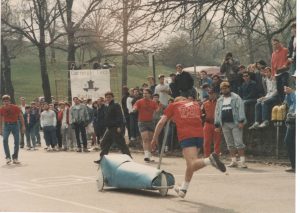
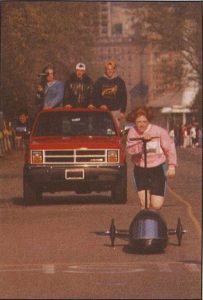

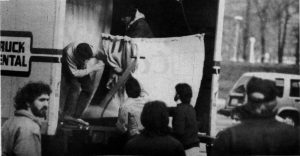
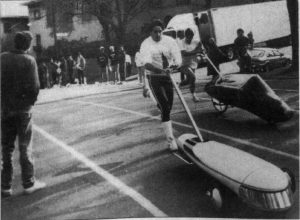
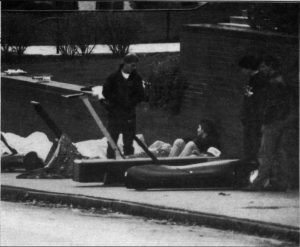
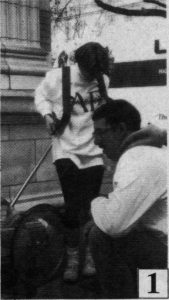
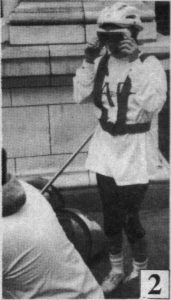
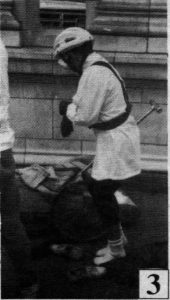
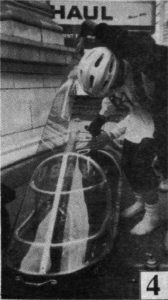
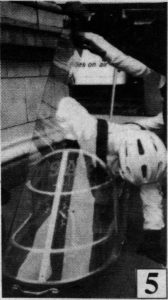

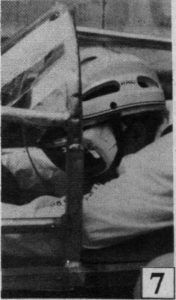
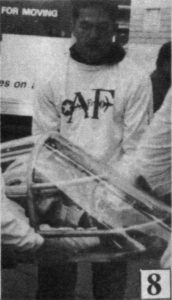


1989
Raceday: Prelims on Friday, April 14 at 8:30am; Finals on Saturday, April 15 at 8:00am
Sweepstakes Committee: Chris Hansen (Chair); Phil Tubesing (Ass. Chair); Trish DiMarco (Safety); Erica Levy, Ray Fratto, and Jeff Nystrom (“Youngsters”)
Men’s Results: (1) Spirit A – Quantum Leap (2:06.576); (2) Beta A – Mercury (2:10.239); (3) PiKA B – Predator (2:12.082); (4) PiKA A – Breathless (2:12.652); (5) Spirit C – Tachyon (2:13.323); (6) Fringe A – Barrier (2:13.767)
Women’s Results: (1) Spirit A – Quantum Leap (2:35.651 – COURSE RECORD); (2) PiKA A – Predator (2:36.574);(3) Fringe A – Barrier (2:45.717); (4) Spirit B – Tachyon (2:49.474); (5) PiKA B – King Solomon (2:55.168); (6) CIA A – Stealth (2:57.198)
Design Comp: (1) SigNu – Pope Jackson; (2) KDR – Paladin; (3) Fringe – Lunatic
Weather: Sunny, 40-54 Degrees on Friday; Overcast, 49-51 on Saturday
Buggy Book: 1989 Buggy Book Link
Prediction Score: 15/55 Men’s, 10/19 Women’s (Compubookie)
The biggest story of the 1989 school year was the elimination of the 2-wheeled buggy, much to DU’s chagrin. But it wasn’t the only story of the year, which saw some interesting spins and an amazingly fun heat between 2 staples of the Buggy community.
- Death of the 2-Wheeler. There is no doubt that two-wheeled buggies are particularly fast; they are also particularly dangerous. As Lou Conley pointed out in the February 7, 1989 Tartan, 2-wheelers have 3 key problems that make them dangerous: (1) they are statically unstable (they fall over when not moving); (2) they fall over on the course if bumped; and (3) they fall from a height. Lou argued that “2-wheeled buggies should have been banned long ago”. King Eider seemed like a game changer when it put up a (brief) course record in the 1988 Prelims, prompting other organizations to start making plans to build a two-wheeler. Instead, it was its Finals roll that became the game changer, with its toppling on Hill 2 leading to a move by Sweepstakes to depose the King (and all other 2-wheelers). According to Ron Campana of Student Affairs, there was enough of a concern on the Sweepstakes committee that other orgs would try to build 2-wheelers that aren’t up to the safety standards of DU’s buggies, and so in the interest of safety, Sweepstakes made the decision in May 1988 to ban new 2-wheeled buggies for the 1988-1989 School Year. DU was still permitted to race their currently existing buggies and drivers, but they would only be permitted to race in solo heats in both the Prelims and Finals. During the year, Sweepstakes stated that they would try to craft formal rules for 2-wheeled buggies, but if they weren’t able to come up with regulations that would protect the safety of everyone involved, 2-wheelers would be permanently banned and DU would only be permitted to race their current buggies until the current drivers graduate (so that they could be phased out). By January 1989, Sweepstakes realized that they would not be able to come up with sufficient safety rules for 2-wheelers, and so they put the permanent banning of two-wheelers to a vote. And when the votes were counted on January 30, 1989, 2-wheelers had been banned (though it wasn’t unanimous; the February 7, 1989 Tartan noted that Beta voted against the ban and PiKA voted in favor of the ban).
- DU Objects. DU was understandably upset about the sudden ban. The ban allowed them to race their 2-wheelers for Raceday 1989 in their own solo heats, but DU had stated that they would not roll their 2-wheelers at all unless the decision was reversed. DU appealed the ruling to Sweepstakes Chair Chris Hansen on February 3. They argued that there was no objective measure for 2-wheeled safety proposed by Sweepstakes, and based on the number of incidents that DU had and the number of rolls they completed, they were no less safe than any other organization. But other organizations had expressed concerns to Sweepstakes about rolling with DU, and the final decision was that the appeal was denied. All DU was left with to protest the decision was their 1989 Buggy T-Shirt, which contained 3 fluorescent pink breasts and read “Forced Evolution – Darwin wouldn’t understand either”. But it wasn’t just DU objecting at the time; the ban of 2-wheelers still draws debate today. In 2014, Mark Estes commented on the BAA site that the ban was silly, noting that 2-wheeled bikes had been around for a long time without issue. Instead, he argued that the ban was a result of the rule writers being threatened by the new technology, and bad timing (the recent ATO truck fire had put everyone on high alert for any possible safety issues, and a few recent flops of 2-wheelers brought this issue to the forefront). Though DU didn’t do themselves any favors, employing some aggressive tactics to improve speed and sacrifice safety and stability on the course. On the other side, bAA commenter “John”, who was on the rules committee at the time, wrote in 2017 that the ban was simple; the buggy tipped over often, and even if the driver wasn’t injured, it created a hazard for all drivers and pushers on the course (since it tipped over on the hills). A column in the April 25, 1989 by columnist Josh Ruben seemed to sum up a concern about the ban that many likely felt at the time: “Since two-wheeled buggies have been banned, buggy technology has gone as far as it can go. Sure there may be some minor design or structural variations, but in terms of designing a radical new ‘super buggy’, it ain’t gonna happen.” Either way, the ban left DU with very little time to build a new 3-wheeler for Raceday. Of course, it almost didn’t matter if they had been allowed to race a 2-wheeler on Raceday even if they wanted to, because…
- The King Has Been Overthrown. One week after Raceday 1988, DU made a trip to their garage, where their buggies were stored. When they entered the garage, they discovered something they didn’t expect…King Eider was missing. Someone had broken into the DU garage and stolen their course record-setting buggy. The brothers had a guess about who had stolen it – the brothers of Beta Theta Pi. DU tried to find the buggy, even taking a late night trip to their main suspect’s family house to see if the buggy had been taken there. But it was no use. The buggy was never to be found again. This left DU with just Horned Screamer. Even though the temporary ban had been put in place at the start of the 1988-1989 school year, having a buggy stolen was a difficult way to end an era, so according to the February 8, 1989 Tartan, Anne Witchner and the Alumni Advisory Board offered to help rebuild King Eider. Sweepstakes had agreed that if a new King Eider could be built that was identical to the original version, the buggy would be able to roll under the special circumstances on Raceday 1989. DU bought the relevant parts but declined the assistance of the Alumni Advisory Board. However, once Sweepstakes passed the permanent ban, DU elected not to rebuild their buggy (presumably because it wasn’t worth the time and effort to rebuild a buggy that could only race 1 time).
- Buggy vs. Student Government, 1989 Edition. In 1989, Student Government increased the allocation of funds to Sweepstakes from $8,735 to $9,010. But the good news for Sweepstakes didn’t extend to Buggy organizations. The Student Senate did vote to keep the same policy as was passed the previous year, allowing for Buggy orgs to use Student Senate funding to build a new buggy, provided that 10% of the costs came from sources outside Student Government. However, they added an additional restriction: organizations may now only request funds to build a new buggy three years after they previously received funds for the same purpose. What spurred this on, you may ask? Well, it seems to stem from a battle between Student Government and the fraternities on campus. Multiple Tartan articles written throughout the school year reported that Fraternity members wanted a portion of their student Activities Fee refunded (the proposal seemed to settle on 37% of the fee). One of the main arguments made by the fraternities was that if a portion of the Activities Fee goes to support buggy organizations, then fraternities are essentially funding their own competition. This fight would continue to rage on for years.
- Practice Problems. Spring Rolls began on the weekend of February 25-26, and ran every weekend until Raceday (except for Sunday, March 26). But bad weather cancelled some of those rolls and caused several orgs to try to get faster quickly, resulting in a larger than usual number of crashes during the Spring. Meanwhile, one of the Spring push practices didn’t go so well for the brothers of PiLam. According to the March 8, 1999 Tartan in their “10 years ago” feature (we don’t have the original source), 3 PiLam brothers were out at buggy practices (we assume this is referring to a push practice) when they were assaulted. 2 indviduals were drunk and showed up at practice, and started to verbally harass the 3 PiLam brothers. Then one of the strangers picked up a wrench and threw it at the brothers, hitting a brother in the face. The two assailants drove off before police arrived.
- New Buggies of 1989. Some new buggies hit the course in 1989. Theta Xi wanted to give their buggy Caesar a run for its money, so they built a companion, Brutus. Fringe put together an orange buggy with black stripes and fittingly named it Tygr. KDR officially instituted their P-theme with 2 new buggies, Paladin and Prometheus, while Beta went back to their Roman and Greek gods theme with Mercury. DTD and KapSig produced Loc-Nar and Arabian, respectively, while Pioneers and Spirit added Edge and Tachyon to the mix. PhiKap may have been celebrating something, as their new buggy earned the name Centennial. And SAE decided to build their first new buggy in over a decade, producing Quasimoto.
- Predictions. Compubookie had a rough year. On the women’s side, he correctly predicted that it was a two-team race between Spirit and PiKA/Theta, but he declared PiKA the “clear favorite”, which turned out to not be the case. Meanwhile, his top pick on the Men’s side went to SigNu A, based on the fact that SigNu had been winning rolls lately, and as long as they could clear the Chute, they should have an excellent chance. His full Men’s top 10 was: (1) SigNu A, (2) Spirit A, (3) PiKA A, (4) Beta A, (5) Fringe A, (6) KDR A, (7) PiKA B, (8) Spirit B, (9) Theta Xi A, and (10) CIA A. He also predicted the Alumni results, expecting Sweepstakes to pull off the victory, with SigNu 2nd and PiKA 3rd. But he also got himself into some hot water again over one of his organizational one-liners, with multiple Letters to the Editor in the April 25, 1989 Tartan objecting to a “blatantly sexist” remark in the article (we don’t think it’s worth repeating here).
- Spirit Gets Serious. Having set the Men’s course record in 1988, Spirit was set for an encore. But as the reigning champion, they knew that others would want to steal their secrets. So Spirit’s solution was to employ guards to protect their buggies. The April 18, 1989 Tartan reports that Spirit had 4 women or men, with sunglasses and Spirit T-Shirts, standing at the mouth of the van at all times. And much like the Palace Guards, the Spirit Guards never moved or cracked a smile.
- The Fun Heat. The biggest rivalry in Buggy continued in 1989. No, not PiKA and SigNu, or PiKA and Spirit, or any of the other organizational battles. It was the duel between SAE C’s Limo and PiLam B’s Miss Budweiser. For some reason, those two buggies, plus Beta D, raced in a special heat designed as Men’s Prelim Heat 7a (why wasn’t it just called Heat 8? I don’t know). Beta D easily won the heat, finish in 2:46.12. Meanwhile, the epic battle began between Miss Budweiser (from Lane 3) and Limo (from Lane 1). Per the April 18, 1989 Tartan, Miss Budweiser was equipped with a new feature in 1989 – an elaborate horn. But the horn was no match for the pageantry of SAE, as they decided to turn the entire race into a themed social commentary. SAE decided to perform a parody of a fight between police and fans at a Grateful Dead concert in Pittsburgh. All of the pushers dressed in tie-dye t-shirts, shorts, and bandanas, while other SAE brothers dressed in police costumes and “attacked” the would-be deadhead pushers with plastic billy clubs while they pushed. To put the finishing touches on the performance, Limo was equipped with a radio and the team blasted the song Truckin’ out of the speakers. The race itself was pretty much an afterthought (SAE’s pushers reportedly waved to the spectators as they pushed the buggy). PiLam ended up winning the battle but it was surprisingly close, with Miss Budweiser crossing the finish line in 5:55.57, compared to Limo’s 6:00.99, but it seems likely that the spectators didn’t mind this heat taking a little longer than the typical race. But fun fact: Spirit’s Quantum Leap would have finished the course twice, and made it back around to the Hill 4-5 Transition a 3rd time, before SAE crossed the finish line.
- Top Spins. The April 18, 1989 Tartan was nice enough to publish the “top three most interesting buggy wipe-outs at the Chute”. #3 belonged to Fringe B’s Tygr. Running in Men’s Prelim Heat 8 against KDR A and SDC C, one of Tygr’s rear wheels blew out during the Chute turn, causing the buggy to spin and do a complete 180. As the buggy leaned into the Chute, it appeared that the rim of the wheel dug into the tire, causing the blowout and wheel loss. #2 on the list came courtesy of PiKA C’s Thunder in Men’s Prelims Heat 10. Against Spirit B and Theta Xi C, PiKA C’s driver took the Chute turn too wide, scraping against the outer bales and ripping off a wheel. The buggy scraped the bales for approximately 25 feet before finally stopping. The “unanimous” #1 spin-out on the list, though, was PiLam A’s Legend in Heat 13. Going up against PiKA A and SigNu D and just after completing the Chute turn, an unidentified piece of the buggy approximately 2 square inches in size, suddenly flew off of the buggy. As soon as it became dislodged, the buggy spun into a complete 180, and the buggy rolled backwards into a haybale. One other spin that we know about was PhiKap A’s Tempest, though it didn’t crack the top 3.
- Spectators Beware. Every once in a while, a spectator finds themselves in an unfortunate position with a buggy bearing down on them. Typically, it’s because the spectators are somewhere they shouldn’t be, or are paying attention to one buggy while another one comes towards them unnoticed. But in 1989, as best we can tell, spectators on Hill 2 weren’t doing anything wrong. SDC’s Fury, its newest buggy, raced in both the Men’s and Women’s heats, we believe as the A team in both. But it earned DNFs in both races, and for an unexpected reason. In the Women’s heats, the buggy spun out after receiving the final shove on Hill 2. Just to prove this wasn’t a fluke, Fury did the exact same thing in the Men’s heats, again spinning out on the Hill 2 shove. In the Men’s race, however, the buggy lost a little more control. The buggy spun into the crowd, reportedly hitting several spectators. The April 18, 1989 Tartan has conflicting reports over whether there were injuries; one article says that the buggy ran into some spectators “but no one was hurt”, while another says that “unfortunately, injury did occur to watchers” in the Fury Hill 2 incident, and that “in addition, several pushers sustained abrasions.” The article reporting injuries does not that this was an “unseen” accident, as the reporter was down in the Chute, so we think it’s more likely that there were no injuries, but if you know which of these two stories is correct, let us know!
- Other Prelims Miscellany. For some reason, most Racedays seem to have a certain type of DQ that is the most popular for the year. In 1989, that DQ appears to have been Pushbars, as the April 18, 1989 Tartan reports that several teams missed the pushbar on both Friday and Saturday. In addition, the April 18, 1989 Tartan reports that both Beta A and DU A failed drops; based on what we know from the Men’s side, we assume that the Beta A team that DQ’d for drops was the Beta A Women’s team. And although teams can’t get DQ’d for fashion choices, maybe they should. Men’s Prelims Heat 14 was a battle between Spirit A, Fringe A, and KapSig A, but WRCT described the race as “just a sea of yellow and gold shorts.” And we didn’t just have buggies on the course in 1989. After the Women’s Heats on Friday, GM brought out their Sunraycer to race around the course. The GM Sunraycer was a solar-powered car that won the 1987 World Solar Challenge. It completed the buggy course in 1:29, reaching a speed of 58mph at the Monument.
- Wheel Tech of the 1980s. In the comment section below, Mark Estes provided amazing insight into the wheel technology of the 1980s. There’s no great spot to include this above, but just in case something happens to the comment, we wanted to post it (lightly edited) here:
- Goodyear Tires
- The wave of fast rubber from Goodyear in the 1980s left a bit of a “haves” and “have-nots” on campus. The Goodyear stuff was really quick but a bit fragile. During the 1980s many teams, including PiKA, Beta, SigNu and PhiKap all had managed to get some of these Goodyear tires at some point. The rubber was really a step up over the prior best in class which had been soap box derby rubber from select years (not all soap box derby rubber was created equal). Not all batches of Goodyear rubber were created equal either. SigNu’s original shipment in 1981 was split between really good and great. SigNu ran the great stuff until it could run no more.
- A change in the Goodyear tire design happened at some point and a batch that SigNu received in 1986 caught the team off guard. From outward appearances, the tires looked the same, they tested the same, and when rolled in practice, they rolled the same. It was not until they were race prepped that the difference eventually came clear and it was a painful lesson, with many of SigNu’s buggies spinning out in 1986 and 1987. This was despite no signs of trouble in heavy practice in 1986 and again in 1987. In hindsight, there was a difference in design between the batches which one could not see without dissecting the tires and that was not going to happen while the tires were still round.
- In 1988 or 1989 (I cannot recall), it appears that Goodyear grew tired of all the individual requests and opened up the gates for all comers. The joy of getting access to Goodyear rubber was soon deflated when the batch that arrived for the masses was clearly a dud.
- Panaracers
- Another wheel development during the late 1980s included the emergence of the pneumatic wheel chair racing wheels and tires from Panaracer. The Panaracers were available in 3 sizes, all of them with misleading labels (i.e., the “12 inch” was nothing like 12 inches). Many of the non-Goodyear crowd embraced these with goodly success (KDR, Fringe, SDC, PhiKap). They were very light and reasonably quick. They were also in short supply and that supply got shorter every year. These became the go-to wheel for Spirit during their dominant run. Like any pressurized tire, they were slow when under inflated and there was a temptation to increase the pressure well beyond the recommended limit. More than one race was ruined by the distinct gun-shot pop of a pneumatic tire letting go in anger.
- Smaller Wheels
- The other major wheel development of the 1980s was the introduction of the smaller wheels used by PiKA. These allowed for buggy designs where the axle did not want to run through the center of the driver’s body (which is what happens when you try to package 12 inch wheels). Such designs appeared to be on on the low mass side to this observer.
- Small wheels also made the push easier by lowering the total mass being pushed and reducing the rotating mass being accelerated. Theory says that smaller wheels should have a higher rolling resistance; unfortunately (at least from an outsider perspective), that theory did not bother to visit the PiKA buggies. Small wheels also allowed for interesting aerodynamic approaches as they were easier to tuck inside of bodywork without that bodywork becoming huge (which resulted in the large bodies of Black Magic, from CIA, and the first incarnation of Jama (1990) from SigNu). PiKA started the parade towards smaller wheels and had the field to themselves with tiny wheels with the exception of a few failed experiments during the 1980s. SigNu tried some tiny urethane based wheels in 1987 but had to shut it down before Raceday. Pushers loved them and they made ordinary pushers into supermen on Hill 1. However, the buggies did not go through the freeroll at a respectable pace. Years later, SigNu eventually figured out a smaller wheel design which made the redesign of Jama (1991) possible and allowed SigNu to join PKA in the small wheel club. A decade later, Fringe ushered in the Xootr revolution with their first win. The movement to the Xootr sized wheel was accelerated by crossover from soap box derby’s Ultimate Speed Racing into the very fast custom urethane we see today. The combination of speed and durability available in today’s urethane wheels (AEND/Zero Error and others) is remarkable. The choice back in the 1980s was one or the other.
- Goodyear Tires
- 1989 Photos. Below are photos from 1989.
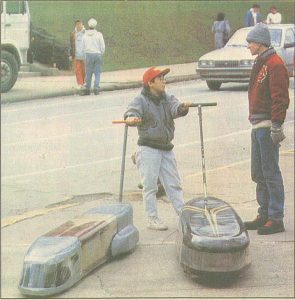
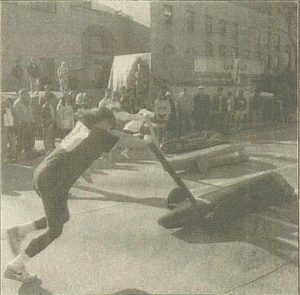
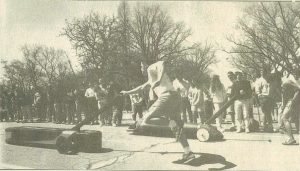

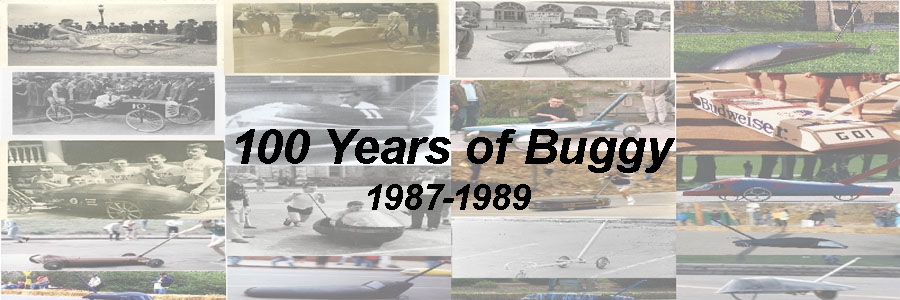
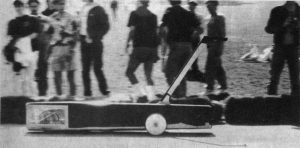
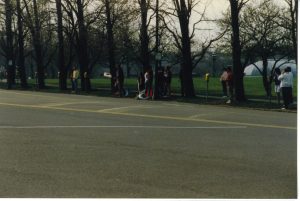
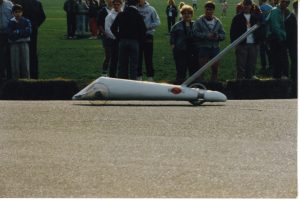
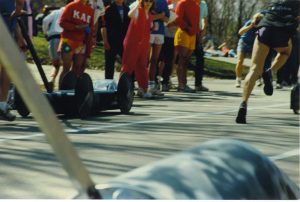
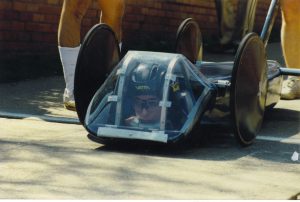
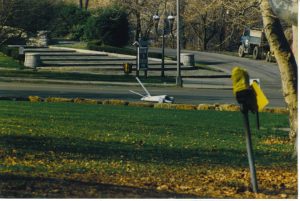
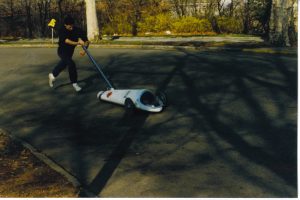
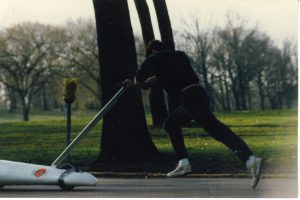
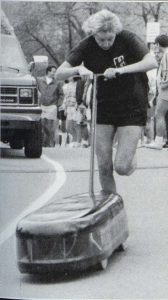



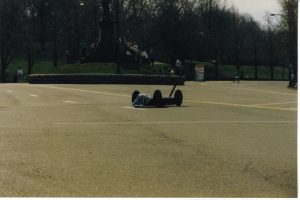

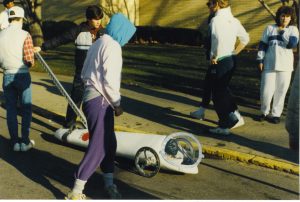
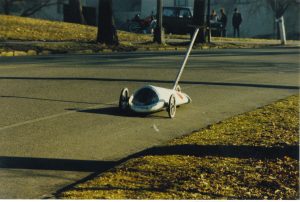
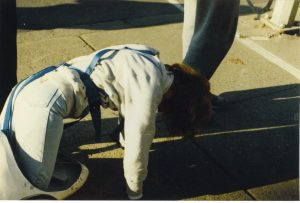
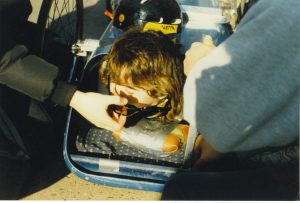

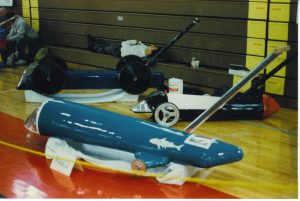
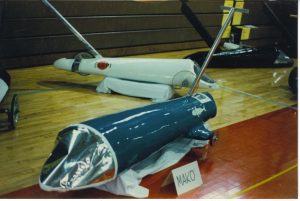



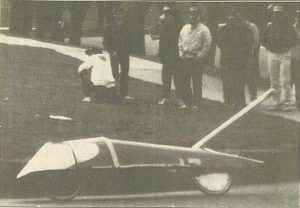
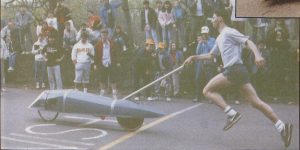


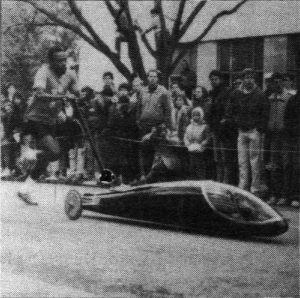

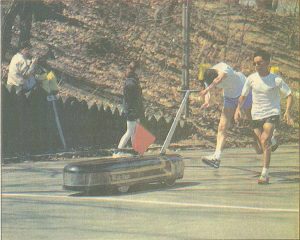
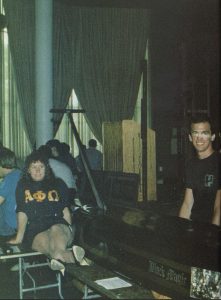
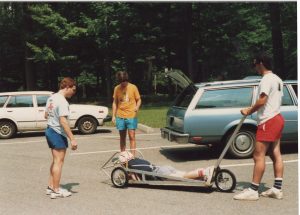
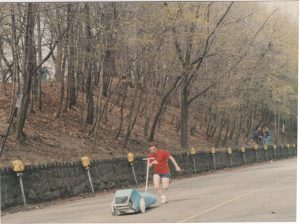
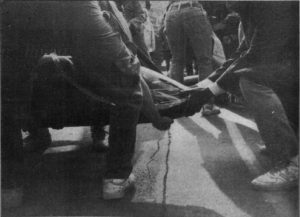

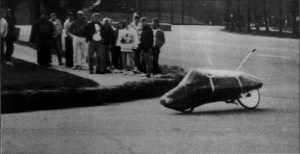
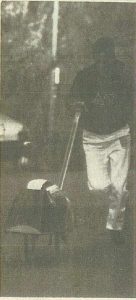
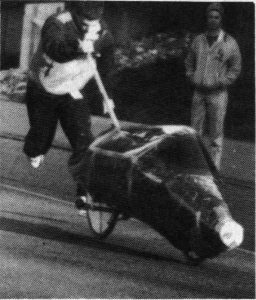
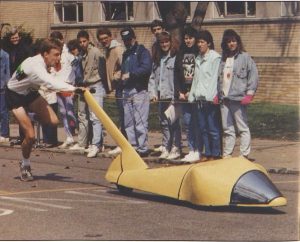

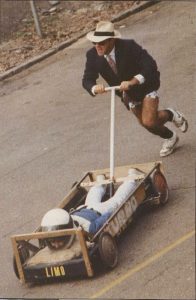
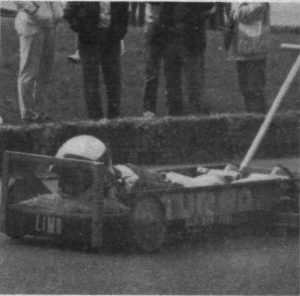

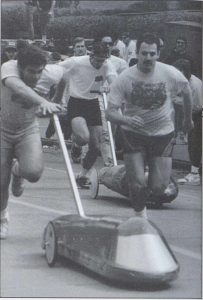
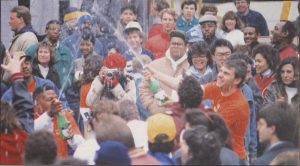




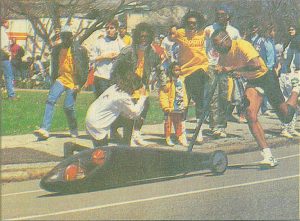

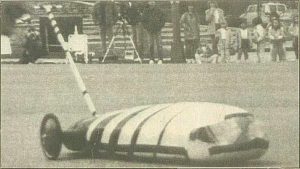
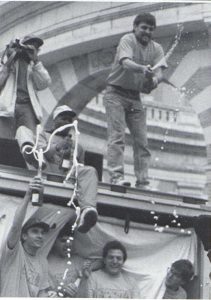
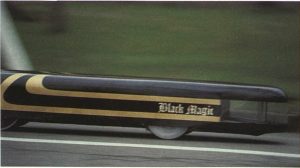

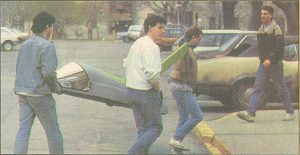

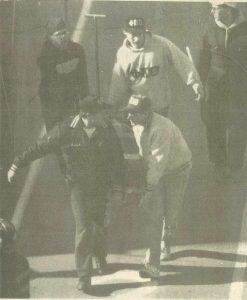
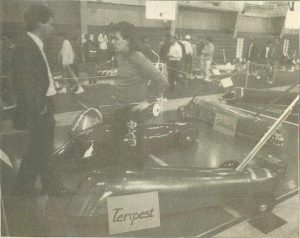
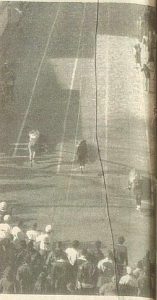

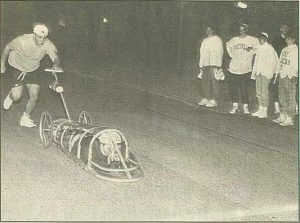
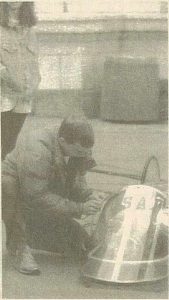
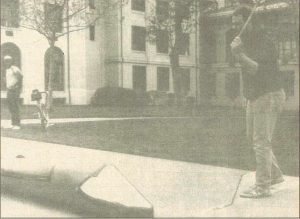
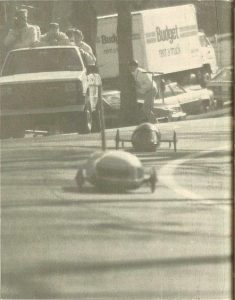
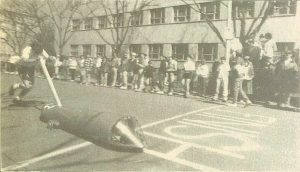
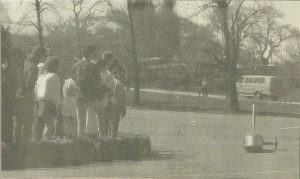

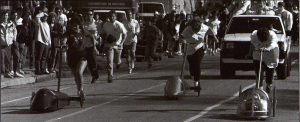
Slick says:
Who was on crowd control of the 1987 award ceremony and why were these people allowed the mic?!
the Pope says:
Comments on controversy of the 87 finals rain-out.
There was more than one team waiting to roll when the finals were canceled. Re-rolls were lined up as well.
We had spun our A team in the prelims ( dark days for us) but had 4 of those pushers on our B buggy in the finals. We promptly ran that buggy into the outside curb on hill 2 (it was close going up and over and we got pushed wide). The resulting roll was what you might expect when your left wheel is is stark disagreement with the rest of the squad. That buggy, nemesis/ pope jackson was a poor choice for a or b team it really was our slowest buggy of the lot (design flaws in our early carbon construction plagued this buggy and Yamabachi ). I believe I put it there out of stupidity and a desire to win design.
Anyway, after that debacle of a finals heat, I asked for and was granted the most silly of re-rolls, which allowed substituting in my D buggy, Colugo for the A buggy. I argued that the B buggy was damaged beyond immediate repair. The rules do not discuss what to do in this case. Had we rolled, I am sure more more controversy would have ensued.
This re=roll solution may seem like a hopeless case but that D buggy had just cracked an impressive free-roll time in the alumni heats (the winning 85 pushers wanted to have some fun so they got a fully prepped buggy) and she was ready to rumble. The driver was qualified for both buggies. I recall sweepstakes committee being on board with the deal as long as the PKA buggy chair agreed ( I cannot recall why their opinion mattered).
Since he was also my ME lab partner, and a reasonable chap, the deal was done. (the world was not all ESP and FYZ despite the hype) Thus, there was actually more than one heat remaining when they called the race and I believed both BETA and SN had a legit shot at a winning time. But, as they say: scoreboard.
I remember rain call as happening as we brought the buggy out of the truck but I am not entirely sure that is accurate. There was scant water on the course when it was called (only a few drops had fallen). I do recall that we knew rain was coming and I kept urging them to shorten time between heats (they were slated at some long interval like 10 or 15 minutes). We were up next and only needed about 2 minutes notice to be on the line. I wanted to roll I could taste victory. I was not an objective actor at that time. So, the controversy was legit. In light of the circumstances, including the fire and focus on safety, I can see how the decision to err on the side of safety was made. I will also note that races have been held on wetter courses since and that rubber tires had much less of an issue with water than the urethane tires of today.
the Pope says:
After pondering this further today, I recall that our men’s b buggy was also running for one or our women’s teams and it was during their final heat the the curb on hill 2 was encountered. Thus, confirming all the concerns our alumni had shared about the wisdom of letting that buggy run in women’s and showing my stupidity for ignoring them. I believe we tried to patch it up for the men’s finals but with limited success. We got up and over in the finals in good shape (vs a b team) but it was close in the chute (our speed was not there) and we spun. Thus the reroll request.
Bryan Arsham says:
This is great! I have a question on the naming of the 1987 buggy though: The SigNu shirts clearly said Nemesis, but it looks like the buggy was always referred to as Pope Jackson (or Pope), and clearly your nickname derived from that. I also notice that Theta Xi built a buggy in 1987 named Nemesis. What’s the story there? Is there one? As someone who wasn’t there, seeing “Nemesis” on a shirt initially had me tagging a photo as Theta Xi, until I noticed it said “Sigma Nu buggy” on it, so I’d love to know what happened.
the Pope says:
TX and SN both build buggies and both called them Nemesis when they were launched in spring 87.
There was disagreement over who could/should use the name. I do not recall either side being too bent out of shape over it. Both sides based t-shirts on the same name.
That minor pissing match was settled when our alumni swarm (they were very active in the 80s) arrived for buggy and promptly renamed it Pope Jackson. The name stuck, one of the few non beast-based names in a long line of beast-based names (rat, hornet, scoprion, lemur, cougo, jerboa, yababachi…) but I digress.
“Pope” as it was called was very light. It was our 3rd carbon fiber sandwich based buggy in 3 years of carbon sandwich based buggies build by the same core group of misfits. That experience paid off in terms of low mass/ high stiffness in the body.. Sadly, I still had not figured out how to get the important bits attached/ connected in a way that worked as well as the older truss based designs (Lemur, Colugo) or the truss/carbon hybrid (Jerboa). The zoo eventually figured that out but not in the 80s. The pope was also pretty, and we dressed him up nicely for design.
the cook says:
The pic of Wadsworth pushing is the Pope. Wadsworth was also pretty but ineffective.
the Pope says:
A bit more color on wheels in this era.
The wave of fast rubber from Goodyear in the 80s left a bit of a haves and have-nots on campus. THe Goodyear stuff was really quick but a bitg fragile. During the 80s many teams, PKA, Beta, SN and PKT all had managed to get some of these at some point. The rubber was really a step up over the prior best in class which had been soap box derby rubber from select years (not all soap box derby rubber was created equal). Not all batches of goodyear rubber were created equal either. Our original shipment in 81 was split between really good and great. We ran the great stuff until it could run no more.
A change in the GY tire design happened at some point and a batch we received in 86 caught us off guard. From outward appearances, they looked the same, they tested the same, and when rolled in practice, they rolled the same. It was not until they were race prepped that the difference eventually came clear and it was a painful lesson, with many of our buggies spun in both years. This was despite no signs of trouble in heavy practice in 86 and again in 87. In hindsight, there was a difference in design between the batches which one could not see without dissecting the tires and that was not going to happen while they were still round.
In 88 or 89, ( I cannot recall) it appears that Goodyear grew tired of all the individual requests and opened up the gates for all comers. The joy of getting access to Goodyear rubber was soon deflated when the batch that arrived for the masses was clearly a dud.
Another wheel development during the late 80s included the emergence of the pneumatic wheel chair racing wheels and tires from panaracer. The panaracers were available in 3 sizes, all of them with misleading labels (i.e. the 12 inch was nothing like 12 inches). Many of the non-Goodyear crowd embraced these with goodly success (KDR, Fringe, SDC, PKT…). They were very light and reasonably quick. They were also in short supply and that supply got shorter every year. These became the go-to wheel for Spirit during their dominant run. Like any pressurized tire, they were slow when under inflated and there was a temptation to increase the pressure well beyond the recommended limit. More than one race was ruined by the distinct gun-shot pop of a pneumatic tire letting go in anger.
The other wheel development in the 80s was the introduction of the smaller wheels used by PKA. These allowed for buggy designs where the axle did not want to run through the center of the driver’s body (which is what happens when you try to package 12 inch wheels). Such designs appeared to be on on the low mass side to this observer.
Small wheels also made the push easier by lowering the total mass being pushed and reducing the rotating mass being accelerated. Theory says that smaller wheels should have a higher rolling resistance, unfortunately ( at least from my perspective), that theory did not bother to visit the pka’s buggys. Small wheels also allowed for interesting aero approaches as they were easier to tuck inside of bodywork without that bodywork becoming huge (I am talking to you JAMA 1 and Black Magic). PKA started the parade towards smaller wheels and had the field to themselves with tiny wheels with the exception of a few failed experiments during the 80s. SN tried some tiny urethane based wheels in 87 but we shut that down before raceday. Pushers loved them and they made ordinary pushers into supermen on hill one. However, we could not get them down the hill with respectable pace. Years later, SN eventually figured out a smaller wheel design which made JAMA 2 possible and joined PKA in the small wheel club. A decade later, fringe ushered in the xootr revolution with their first win. The movement to the xootr sized wheel was accelerated by crossover from soap box derby ultimate speed racing into the very fast custom urethane we see today. The combination of speed and durability available in today’s urethane wheels (aend/ZE and others) is remarkable. The choice back in the 80s was one or the other.
Michael Darcy says:
In terms of racing knowledge, this is maybe the most important buggy history there is! Thanks for sharing. This comports with and expands on what I learned in bits and pieces over my years on SDC. If current students are looking to go fast, this is the thread you need to follow and figure out through the present day.
Elmo Zoneball says:
Speaking of tires…. has anyone else ever seen Official Soap Box Derby tires with a internal metal bead in the center of the tire that had a “T” shaped cross-section, instead of the traditional solid circular cross-section?
Any idea what the significance was of these T-cross section bead tires?
the Pope says:
Elmo, yes I have seen it. No, I have no idea what it means. I know that if you make one without a bead and do not glue it into the wheel groove, it will stretch out and leave the wheel while rolling.
nonzero error says:
Thanks for the insights, Mark!
Funny how history repeats itself, even in such specific things as the variable quality of wheel batches…
https://cmubuggy.org/gallery/var/albums/2008-2009/Prelims/Buggies/DSC_1369a.JPG?m=1302289885
https://cmubuggy.org/gallery/var/albums/2010-2011/Raceday/DSCF1796.JPG?m=1302959295
the Pope says:
that particular issue is a lack of primer. not all wheel makers have this issue.
the Pope says:
in the case of the zoo buggy, I suspect low primer plus an over zealous level of voodoo applied to that set of wheels prior to the race. in the case of the pka failure ( and similar on fringe a few years prior) a lack of primer on the metal hub.
The cook says:
I caught that second tire, it came right to Daddy.
the Pope says:
twas your foul hand that set up that stinky mess
The cook says:
A comment about the 88 DU roll with Eider. By modern standards and even the standards of the day, the downhill total time was fast but not unprecedented. SN or Pika certainly had rolled as fast many times. The big wheels take time to get going, so our watches had top of hill to just after chute some 2 seconds slower than a record roll. No doubt much of that was regained on hill 3. Similarly the small Pika wheels would set some astonishing times on the top to mid stop watch, while the 12″ SN wheels would shine on the bottom trap. Ironically we each timed segment that made our competitor shine.
Shafeeq says:
If memory serves, Defiant/Number 9 is semi-notable for being the last serious 4-wheeler built. That was CIA’s foray into small wheels and narrow (even by today’s standards) track in an attempt to slim down the packaging. Unfortunately the weight distribution wasn’t quite right, so despite many attempts to fix, it proved less stable than the 3-wheelers that came before & after. The small wheels on the other hand, were more of a success – every CIA buggy since has used at least one.
Shafeeq says:
I believe we sold Dark Star to KDR to become Renaissance. It appears in its original reverse-trike form in 87 and as a forward trike in the 88 photos.
felmley says:
Some more stuff that may or may not be of interest to the wider world re: Spirit
1987: The Race Day Finals were unfortunate. I think the times would have gone down for all the folks waiting to roll, everyone was hungry. For us, with only 2 years of racing under our belts at the time, we learned more every time we raced a heat. Sting was only 1-year old and still fresh. Contrary to what a Beta said to our Hill 1, that we were praying for rain, we were stoked to be in that heat, to race against that team. Our pushers tended to thrive when the heats were competitive. That’s the reason we always chose Lane 1, not for the straighter line at Hill 2, but because the stagger made us start from “behind”. It was a mental thing that seemed to work.
Later, we were truly stunned by how upset people were about our victory. After the incident at the awards ceremony, we started to worry about a raid on our buggy room. That night, I actually fabricated a big “L” bracket and screwed the door shut from the inside so the only entry was from through the upstairs main entrance to Spirit House. It remained like that for weeks. (The theft of DU’s King Eider in 1988 made that concern not just paranoia.)
Still, many teams welcomed us in with open arms, maybe because of the Cinderella aspect of the rise.
felmley says:
1988: The Pope and the Cook have spilled a little about wheel tech, so I’ll drop a little as well. QL rolled that record with one (red) Derby wheel up front, and Panaracers on the rear. Back then, we had 2 levels of secret sauce. One Matt Wagner did in-house, a cheap and nasty dip we could do in the buggy room before races. The other was done off-site and mailed to us by a Soap Box guy who had been banned and readmitted to the sport several times. The problem with this two-tier system was the huge jump in performance that would give us. It was quite the gamble to go from Truck Weekend on the one to Super Ball the next. Fortunately, we had a kick-ass driver we lured away from CIA with the promise of glory. I think Cathy Lin would have been at home in Formula One.
Now, if we could get these great wheels from a former Soap Box Champion, why the Panaracerson in the back? Weight, nothing more. With all the work it took to run all the aspects of a new buggy team, we never learned to crack open a Derby wheel to lighten it in any way. What we could buy or get second hand was “what we run”. A Derby weighs 6 pounds. a Panaracer, less than 1. QL was not light; it took a lot of Bondo to make it pretty, and it was a wet layup, so it was resin-rich. So with air tires, we dropped almost 11 pounds off the back end. We felt it was better to give the pushers a lighter platform.
How it all came together: On Finals day, you can read above, we had a HUGE delay. And one good idea. We heated the hard rubber with heat lamps back then, pointed at the wheels. Actually, they were pointed at the tires, and spun. One of our mechanics suggested we point them at the metal wheel. So we did, for hours that day. QL raced, in the too-cold, and when it came back, the front wheel was still too hot to touch.
Another secret I think only a few knew at the time: the air tires were marked I think “90 psi max”. The rumor on using them was that one of the frats had tested them up to maybe 160 psi and blew it up, so only go past 150 or so at your peril. That wasn’t quite true. The auto parts market had recently been flooded with cheap, small, 12V or battery compressors. For some crazy reason, these things went up past 250psi. So did we.
the Pope says:
Rubber loves to be hot. The speed delta between cold and hot rubber is much greater than the difference between cold and hot urethane. 6 lbs of hot steel holds about 3.5 times as much tire warming ( or anti cooling as the case may be) capacity than 400 grams of hot aluminum. Heating the wheel was a wise move.
Elmo Zoneball says:
… but dislikes being ignited.
Not that such a thing ever, ever happened … (“asking for a friend.”)
felmley says:
The difference between wise and lucky is really close in these situations.
It was a grand learning experience, being in that pressure cooker of a truck.
Trusting your teammates, your intuition, the opportunities that get thrown in your lap.
This is what makes this an awesome sport.
It definitely helped me to grow.